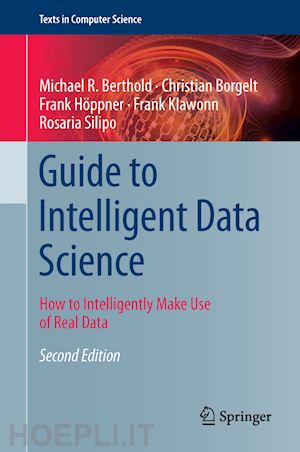
Questo prodotto usufruisce delle SPEDIZIONI GRATIS
selezionando l'opzione Corriere Veloce in fase di ordine.
Pagabile anche con Carta della cultura giovani e del merito, 18App Bonus Cultura e Carta del Docente
Making use of data is not anymore a niche project but central to almost every project. With access to massive compute resources and vast amounts of data, it seems at least in principle possible to solve any problem. However, successful data science projects result from the intelligent application of: human intuition in combination with computational power; sound background knowledge with computer-aided modelling; and critical reflection of the obtained insights and results.
Substantially updating the previous edition, then entitled Guide to Intelligent Data Analysis, this core textbook continues to provide a hands-on instructional approach to many data science techniques, and explains how these are used to solve real world problems. The work balances the practical aspects of applying and using data science techniques with the theoretical and algorithmic underpinnings from mathematics and statistics. Major updates on techniques and subject coverage (including deep learning) are included.
Topics and features: guides the reader through the process of data science, following the interdependent steps of project understanding, data understanding, data blending and transformation, modeling, as well as deployment and monitoring; includes numerous examples using the open source KNIME Analytics Platform, together with an introductory appendix; provides a review of the basics of classical statistics that support and justify many data analysis methods, and a glossary of statistical terms; integrates illustrations and case-study-style examples to support pedagogical exposition; supplies further tools and information at an associated website.
This practical and systematic textbook/reference is a “need-to-have” tool for graduate and advanced undergraduate students and essential reading for all professionals who face data science problems. Moreover, it is a “need to use, need to keep” resource following one's exploration of thesubject.Introduction.- Practical Data Analysis: An Example.- Project Understanding.- Data Understanding.- Principles of Modeling.- Data Preparation.- Finding Patterns.- Finding Explanations.- Finding Predictors.- Evaluation and Deployment.- The Labelling Problem.- Appendix A: Statistics.- Appendix B: KNIME.
Prof. Dr. Michael R. Berthold is Professor for Bioinformatics and Information Mining in the Department of Computer Science at the University of Konstanz, Germany.
Prof. Dr. Christian Borgelt is Professor for Data Science in the departments of Mathematics and Computer Sciences at the Paris Lodron University of Salzburg, Austria; he also co-authored the Springer textbook, Computational Intelligence.
Prof. Dr. Frank Höppner is Professor of Information Engineering in the Department of Computer Science at Ostfalia University of Applied Sciences, Wolfenbüttel, Germany.
Prof. Dr. Frank Klawonn is Professor for Data Analysis and Pattern Recognition at the same institution and head of the Biostatistics Group at the Helmholtz Centre for Infection Research, Braunschweig, Germany; he has authored the Springer textbook, Introduction to Computer Graphics.
Dr. Rosaria Silipo is a Principal Data Scientist and Head of Evangelism at KNIME AG, Zurich, Switzerland.











Il sito utilizza cookie ed altri strumenti di tracciamento che raccolgono informazioni dal dispositivo dell’utente. Oltre ai cookie tecnici ed analitici aggregati, strettamente necessari per il funzionamento di questo sito web, previo consenso dell’utente possono essere installati cookie di profilazione e marketing e cookie dei social media. Cliccando su “Accetto tutti i cookie” saranno attivate tutte le categorie di cookie. Per accettare solo deterninate categorie di cookie, cliccare invece su “Impostazioni cookie”. Chiudendo il banner o continuando a navigare saranno installati solo cookie tecnici. Per maggiori dettagli, consultare la Cookie Policy.